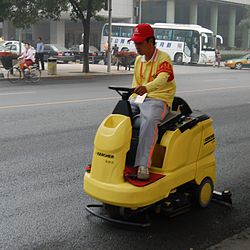Street cleaning
The street cleaning is used to keep clean and ensure navigability and accessibility of the road network of cities and municipalities .
The traditional cleaning by street sweepers without a vehicle, only with a dustpan, broom and wheeled garbage can, is hardly to be found anymore; rather, sweepers or (small) trucks are mostly used. In large cities with total distances of over 1,000 km, several thousand tons of rubbish have to be disposed of every year .
In addition to the ubiquitous dust (e.g. from soot deposits and tire abrasion , but also from rock dust, pollen, fiber dust, skin flakes, fungal spores and other abrasion), all types of improperly disposed household waste arise . In addition, the fall of leaves , snow and gravel after winter use and finally also dog excrement and oil pollution represent the greatest problems of road pollution. Furthermore, it must be ensured that no uncontrolled growth of plants damages the road surface.
Streets are often classified into cleaning classes depending on the volume of traffic , the type of street, the development and the pollution .
When sweeping with road sweepers, the road dirt is often sprayed with water to bind the dust and prevent it from being stirred up. In some cities, such as Paris for example, certain locations are even completely wet cleaned by flushing the non-coarse waste into the sewer system with a water jet .
Historical

The early street cleaning was done by hand as early as the 19th century with the help of road sweepers and in this way saved a lot of costs for the larger city administrations. For drawing the dirt from roads were special honing in use, in which narrow, collect by springs on the road surface scraper pressed tighter dirt and were deposited at the side of the machine as a strip. Asphalt roads require special cleaning as they form a smear layer in damp weather, which could be dangerous for horses and pedestrians. These roads were after previous sprinkling with water - usually by Sprengwagen run - wiped clean with a rubber brush.
By adding oil or tar , the formation of dust could later be successfully reduced. In the USA they used the cheap petroleum there. In Europe since 1902, the method named after the French engineer Guglielminetti has been used with heated tar, which forms a road surface that lasts for several months and strengthens the road.
Special feature: Paris
A special kind of street cleaning is carried out in Paris : In addition to the drinking water network, the city has a second water network with non-potable water, which in addition to the irrigation of parks and the like. a. is also used for street cleaning. The 1700 km long network runs along the gutters of the streets. By opening the "bouches de lavage" (cleaning mouths) embedded in the curb, this water can be flushed onto the street, which is why you can often see water flowing along the gutter in Paris even on dry days. The water comes from the Canal d'Ourcq and the Seine , is filtered in three treatment plants and then collected in seven containers distributed across Paris until it is used. When cleaning the street, the water points are opened, the water flows to the next lower manhole and removes dirt such as B. cigarette butts with. The dirt is then caught or washed away at the manhole.
Street cleaning fees
The municipalities in Germany charge citizens different amounts for street cleaning costs, depending on the fee schedule. Usually, however, only for cleaning the roadways. The residents, however, are obliged to clean the street adjacent to their property. The front length of the property and the cleaning class (cleaning intervals) are decisive for the level of the street cleaning fee for an adjacent property, but not the actual length of the property on the street in question. The front length of a property may be appropriately modified to avoid injustices. In the case of residential and partial ownership, a separate notification is sent to the property manager as a representative of the community of owners.
If a municipality does not comply with the cleaning obligation, according to a judgment of the Higher Administrative Court of Münster (Az. 2 A 2018/80), residents can claim back part of the road tolls.
See also
- Garbage collection
- Rail cleaning vehicle
- Street cleaning , a short documentary film by Michelangelo Antonioni
literature
- Manfred Wichmann: Street cleaning and winter service in municipal practice , 8th revised and expanded edition, Erich Schmidt Verlag, Berlin 2018, ISBN 978-3-503-17643-4 .
- Martin Wittmaier: Street cleaning through the ages , Neuruppin: TK-Verlag 2003, ISBN 3-935317-14-X .
Web links
Individual evidence
- ↑ Pourquoi of milliers de liters d'eau coulent chaque jour dans les rues de Paris. Retrieved October 26, 2019 (fr-fr).
- ↑ http://www.123recht.net/article.asp?a=2261
